Global Synthetic Polymers Market Size and Trends
The global synthetic polymers market is estimated to be valued at USD 26.32 Bn in 2025 and is expected to reach USD 38.06 Bn by 2032, growing at a compound annual growth rate (CAGR) of 5.4% from 2025 to 2032.
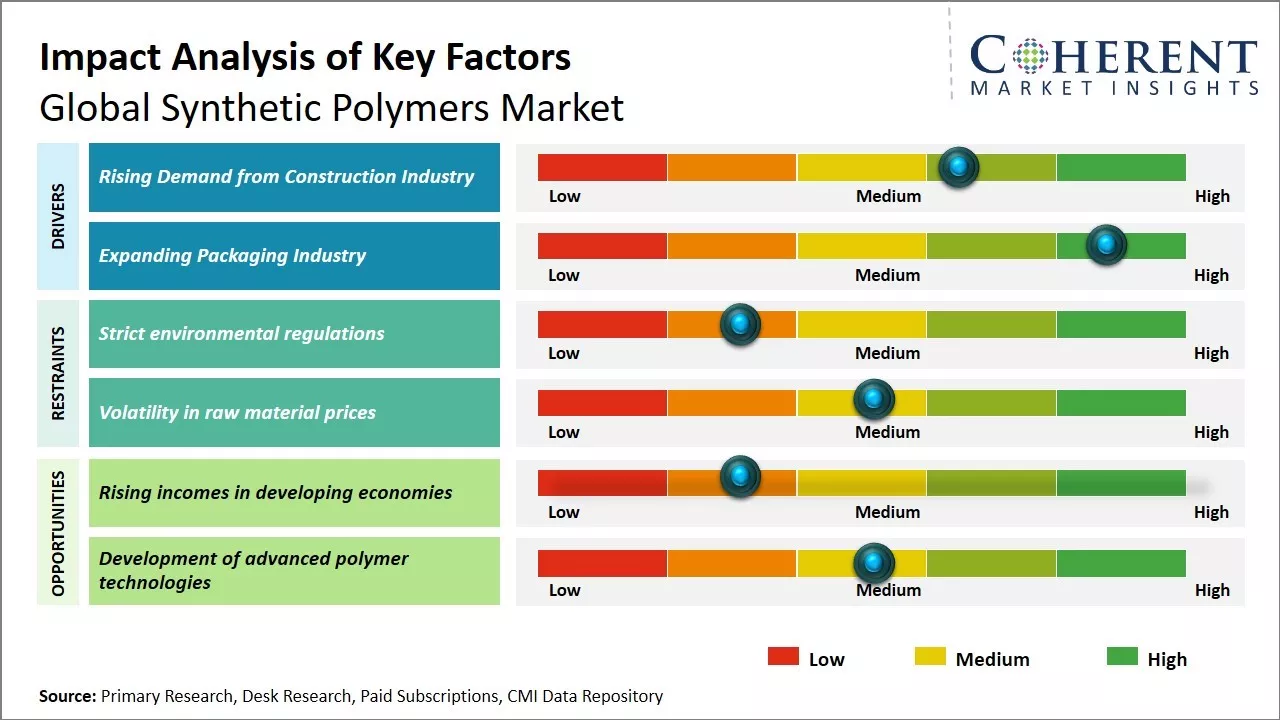
Discover market dynamics shaping the industry: Download Free Sample
Synthetic polymers find wide applications across various end-use industries such as packaging, automotive, construction, healthcare, electrical, and electronics. Growth of the packaging industry along with rising automobile production are expected to drive the demand for synthetic polymers globally during the forecast period. The global synthetic polymers market is expected to witness significant growth over the forecast period. Increasing construction activities in emerging economies coupled with rising disposable income are expected to propel the demand for synthetic polymers. Moreover, the growing need for lightweight and durable materials in the automotive industry along with rising penetration of sustainable and eco-friendly polymers will augment the market growth. However, stringent environmental regulations regarding plastic disposal and recycling may hinder the market growth.
Rising Demand from Construction Industry
The global construction industry has been growing significantly over the past few years mainly attributed to increasing urbanization and industrialization across both developed and developing economies. Rapid infrastructure development including roads, bridges, buildings, dams, and other large construction projects require massive use of various construction materials. Synthetic polymers have emerged as one of the most important construction materials owing to their versatility, durability, and cost effectiveness. Polymers, such as polyvinyl chloride (PVC), polyethylene (PE), polypropylene (PP), and epoxies, find wide usage in piping systems, window profiles, flooring, insulation, tubing, and other applications. Their corrosion resistance, light weight, and easiness in molding make them suitable for varied construction needs. Demand for polymers is particularly high from residential construction sector as global housing construction receives a thrust from swelling middle class population and increasing construction of affordable housing units. The commercial construction sector involving malls, offices, and other workplaces also stimulates polymer consumption for roofing, cladding, railings, and other architectural components. Besides the core construction industry, growing infrastructure of roads, bridges, and railways is propelling the demand for synthetic polymers. Materials like PE, epoxy, and polyurethane are extensively used in the construction of varied infrastructure assets. Flexible PVC finds applications in the fabrication of pipes for the transportation of water, oil and gas over long distances. Rising investments by governments worldwide in upgrading existing infrastructure and adding new infrastructure projects acts as a key driver. Governments especially in emerging nations recognize infrastructure as a driver of overall economic growth. This would continue bolstering consumption of synthetic polymers in the coming years.
Market Concentration and Competitive Landscape
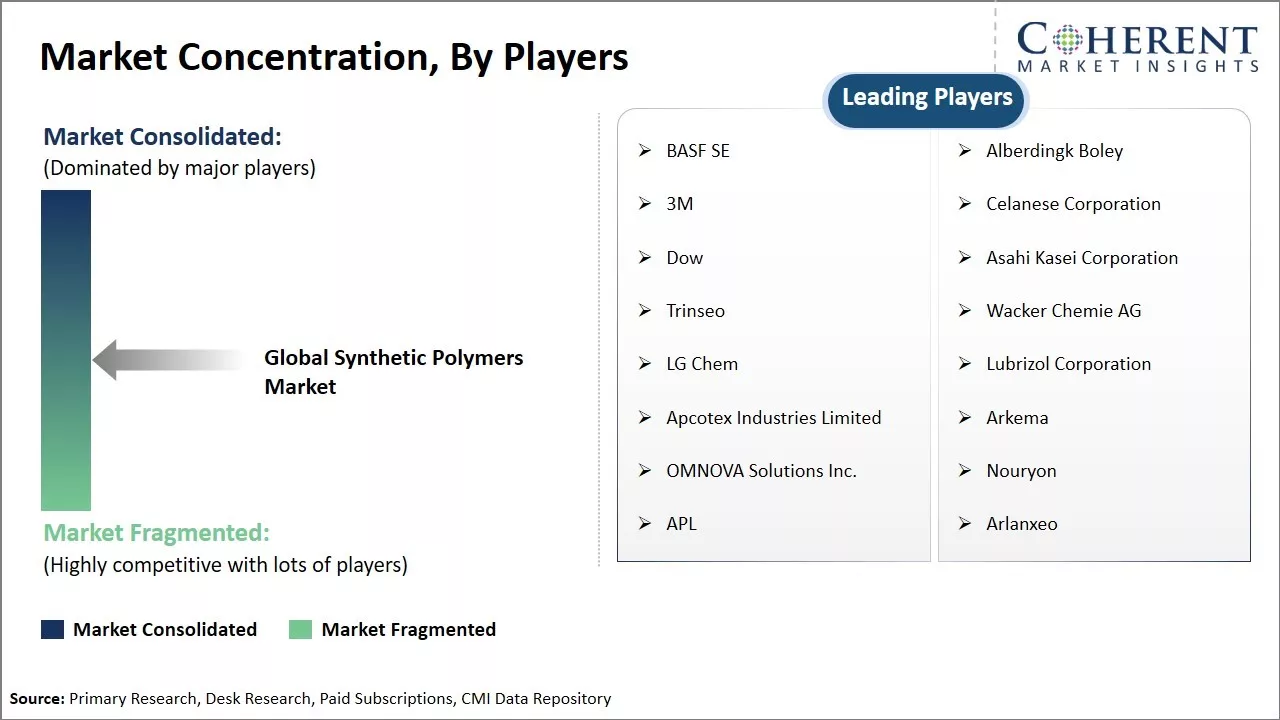
Get actionable strategies to beat competition: Download Free Sample
Expanding Packaging Industry
The packaging industry has been on an upward spiral globally owing to growing needs of consumer packaging across the food, beverage, pharmaceutical, personal care, and other sectors. Synthetic polymers have emerged as one of the most widely used material categories in the packaging industry. This is due to their customizability, affordability, preservation qualities, and sustainability. Polymers like polyethylene terephthalate (PET), high density polyethylene (HDPE), low density polyethylene (LDPE), polypropylene (PP), polyvinyl chloride (PVC), and polystyrene (PS) find widespread applications right from flexible to rigid packaging.
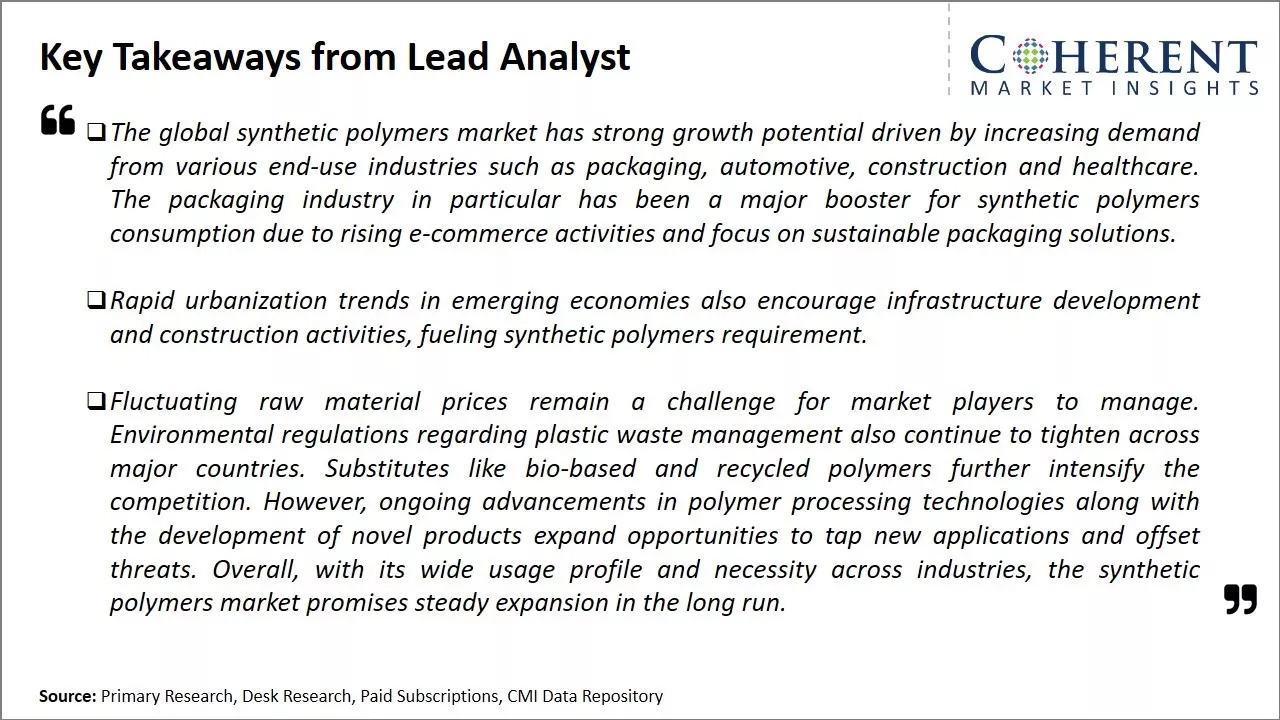
To learn more about this report, Download Free Sample
Market Challenges: Strict environmental regulations
Strict environmental regulations are undoubtedly restraining the growth of global synthetic polymers market. The polymer industry needs to adhere to stringent emission norms and follow responsible production practices. Many governments across the world are imposing regulations to curb plastic pollution and reduce the dependence on single-use plastics. For instance, the European Union passed a directive in 2019 banning select single-use plastic items like plates, cutlery, straws and cotton buds by 2021. Many European nations have additionally implemented plastic bag bans and taxes. Similarly, China aims to ban import of solid waste including plastic scrap for recycling by end of 2025. These regulatory changes have pushed polymer manufacturers to invest heavily in developing sustainable and eco-friendly alternatives. Transitioning to greener production often requires revamping of manufacturing units and supply chains, which is a costly and time-taking process.
Market Opportunities: Rising incomes in developing economies
The accelerating economic development and rising incomes in developing nations can provide substantial opportunities for growth in the global synthetic polymers market. As standards of living increase across Asia, Africa and South America, greater consumer purchasing power is allowing more people to afford everyday plastic-containing products that were previously unaffordable luxuries. This expands the addressable consumer base that global synthetic polymer producers can market to. More individuals on middle-class incomes means growing demand for packaged and processed foods, plastic packaging and containers of all kinds, clothing made of synthetic fabrics like polyester, and personal care goods contained in plastic bottles, tubes and jars. The consumption of fuels, cars, and other durable plastic-containing goods will also rise along with discretionary spending as developing economies mature. The United Nations predicts that by 2030, over half of all middle-income consumers will be located in what are currently developing regions of the world like China, India, Indonesia and others. As populations in these countries number in the billions, even small increases in per capita consumption can translate into huge volumes of incremental sales for synthetic polymer manufacturers over the coming decade. Already low-cost plastics have become indispensable to the economic progression and improved living standards sought by developing nations.
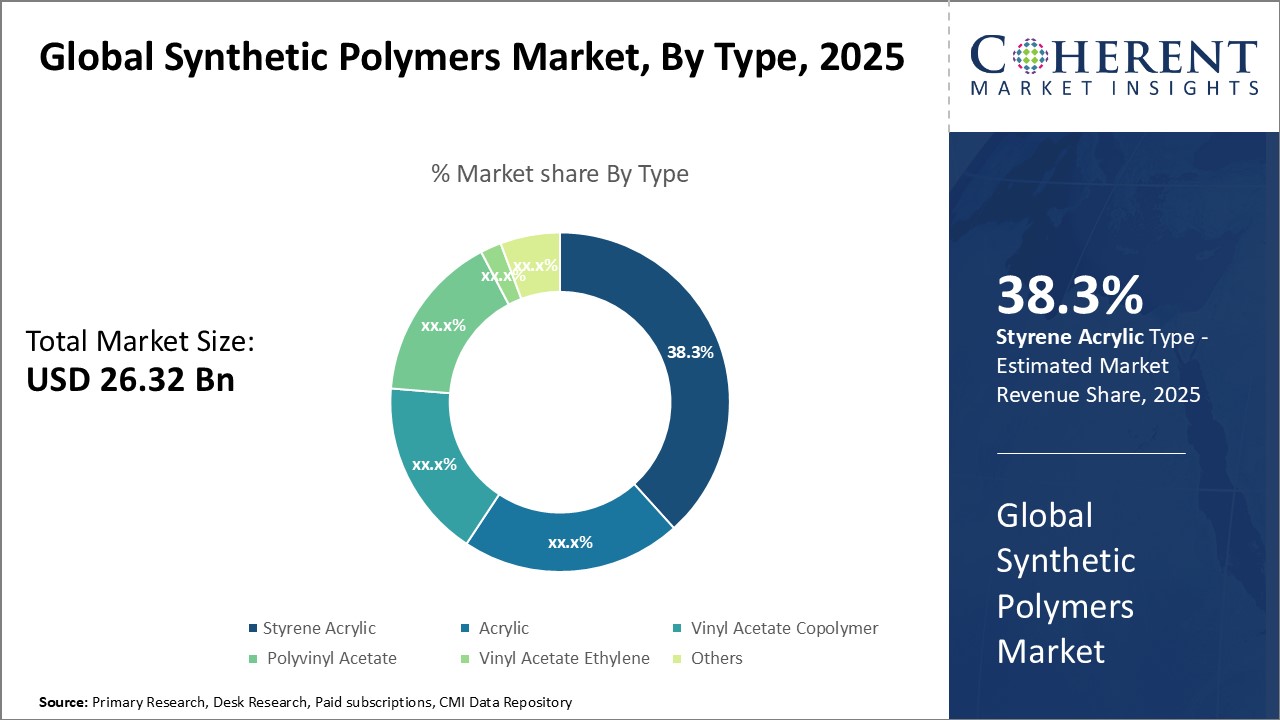
Discover high revenue pocket segments and roadmap to it: Download Free Sample
Insights by Type: Growth of the Construction and Manufacturing Industries
In terms of type, styrene acrylic is expected to contribute 38.3% share of the market in 2025, owing to its wide range of applications across various end-use industries like construction, packaging, and automotive. Styrene acrylic resins have excellent adhesion properties and can bond strongly to various substrates like wood, metal, glass, and plastic. Their high durability and weather resistance make them suitable for use in paints and coatings for exterior applications in construction. The ongoing infrastructure development activities and rising investments in commercial and industrial construction projects in developing nations are driving the demand for styrene acrylic resins significantly. Moreover, styrene acrylic emulsions produce environment-friendly and low VOC containing paints ideal for both interior and exterior use. The manufacturing sector is also expanding rapidly, thus propelling the need for styrene acrylic polymers in industrial machinery, equipment, automotive components, consumer appliances, packaging, etc. Their superior performance characteristics along with compliance with stringent regulatory norms will continue aiding the leading position of styrene acrylic type in the synthetic polymers market.
Insights by Application: Increased Usage in Various Coating Applications
In terms of application, paints and coatings is expected to contribute 36.3% share of the market in 2025, owing to the extensive usage of synthetic polymers across this application segment. Synthetic polymers find widespread application in architectural, automotive, industrial, and other specialized coating applications due to their unique properties. Acrylic resins are often used as binders in architectural coatings due to characteristics like good gloss retention, color retention, durability, and economics. Vinyl acetate copolymers are used in wood coatings for their excellent adhesion to various types of wood. Synthetic polymers also enhance the performance of automotive OEM and refinish coatings. Rapid growth of the construction, automotive, industrial machinery, and consumer goods industries is substantially increasing the demand for high-performance coatings. This coupled with stringent environmental regulations regarding coatings VOC content is propelling the utilization of synthetic binders in the formulation of various greener coating technologies. Their strong binding ability and versatility to impart desired properties to coating formulations make synthetic polymers highly suitable for this largest application segment.
Insights by End Use Industry: Rising Infrastructure Investments in Emerging Nations
In terms of end use industry, construction is expected to contribute 35.8% share of the market in 2025, owing to the rising infrastructure investments in both residential and non-residential building projects across emerging economies. Expanding urbanization and growing disposable income are fueling the growth of the real estate and housing sectors in developing countries. This is positively impacting the demand for various construction materials including synthetic polymers. Their wide application in flooring, roofing, insulation, plumbing, doors & windows makes synthetic polymers an essential component of the construction process. Furthermore, governments around the world are investing heavily in public infrastructure like roads & highways, airports & rail networks, sewage systems, power generation & transmission facilities, etc., utilizing synthetic polymer components. Industry expansion is also witnessed in areas like educational institutions, malls & retail spaces, hospitals, and SEZs. Thus, the steady growth of the overall construction industry, especially in countries like India, China, Indonesia, etc. acts as a chief driver for the end-use industry segment.
Regional Insights
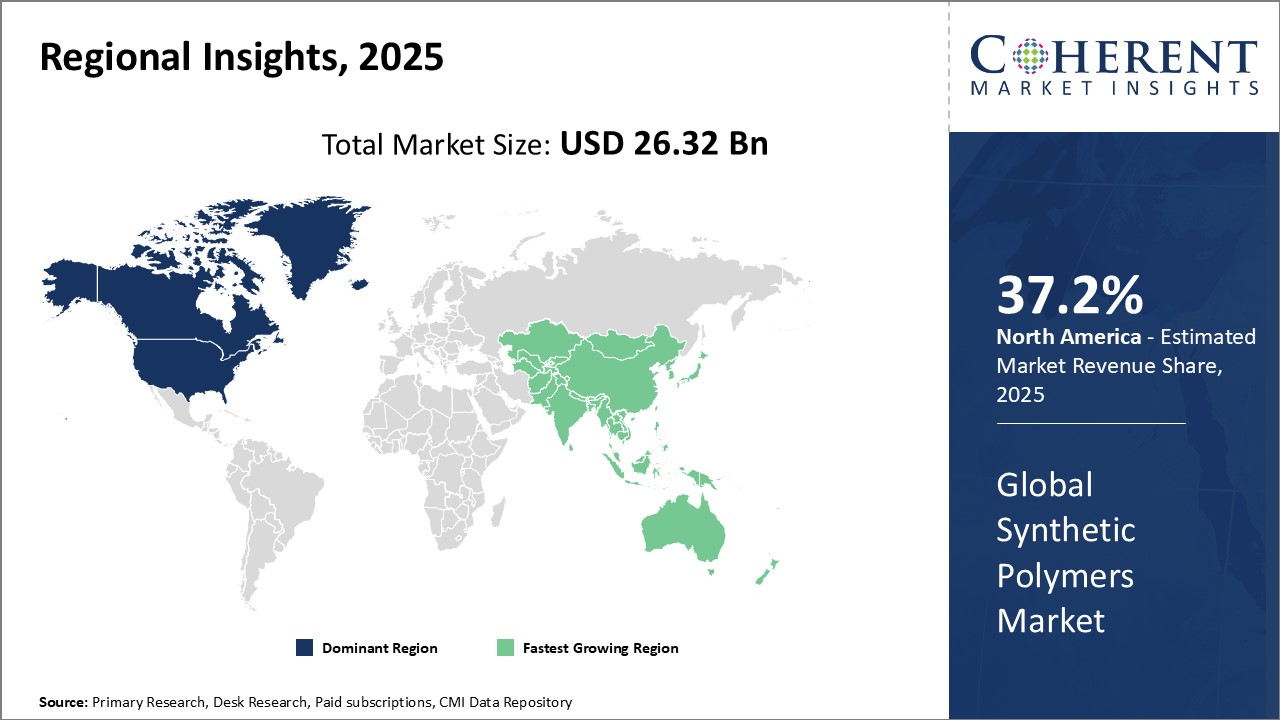
Need a Different Region or Segment? Download Free Sample
North America has been dominating the global synthetic polymers market for a long time due to strong industrial presence and large consumer base in the region. The region is expected to account for 37.2% of the market share in 2025. The U.S. is the world’s second largest manufacturer of synthetic polymers owing to the well-established petrochemical industry and major end-use industries like automotive, construction, and packaging located within the country. Easy availability of raw materials and pro-business regulatory environment have attracted major polymers producers to set up their production facilities catering to both domestic and international markets. The region also has an advantage of price stability over volatile global markets since feedstock supply is largely based on domestic reserves.
However, the fastest growing regional market has been Asia Pacific in recent years and the trend is expected to continue. China plays a pivotal role in the growth of the Asia Pacific market with the country now being the largest producer and consumer of synthetic polymers globally. Factors such as rising incomes, growing urban population, increased infrastructure investments, and expanding manufacturing sector have been driving polymer consumption extensively across industries. Countries like India and Southeast Asian nations are also witnessing heightened polymer demand fueled by robust economic development and government initiatives to boost manufacturing and construction activities. The presence of a large polymer conversion industry alongside end-use sectors has made the region an attractive export hub. While imported polymers currently meet a significant portion of the massive regional requirement, domestic production capacities are increasing at a tremendous pace supported by favorable foreign investment policies of different governments. This is expected to reduce the dependence on imports and provide competitiveness to the Asia Pacific synthetic polymers industry over the long run.
Market Report Scope
Global Synthetic Polymers Market Report Coverage
| Report Coverage | Details | ||
|---|---|---|---|
| Base Year: | 2024 | Market Size in 2025: | USD 26.32 Bn |
| Historical Data for: | 2020 To 2024 | Forecast Period: | 2025 To 2032 |
| Forecast Period 2025 to 2032 CAGR: | 5.4% | 2032 Value Projection: | USD 38.06 Bn |
| Geographies covered: |
|
||
| Segments covered: |
|
||
| Companies covered: |
BASF SE, Alberdingk Boley, 3M, Celanese Corporation, Dow, Asahi Kasei Corporation, Trinseo, Wacker Chemie AG, LG Chem, Lubrizol Corporation, Apcotex Industries Limited, Arkema, OMNOVA Solutions Inc., Nouryon, APL, and Arlanxeo |
||
| Growth Drivers: |
|
||
| Restraints & Challenges: |
|
||
Uncover macros and micros vetted on 75+ parameters: Get instant access to report
Global Synthetic Polymers Industry News
- In May 2024, NSF and industry partners announced a sustainable polymer research funding opportunity
- In 2023, Bioweg and Ginkgo Bioworks announced a partnership to develop cost effective and efficacious bio-based materials to Reduce the use of microplastic pollutants
- A new polyurethane was launched in June 2022 for industrial applications in the cabinet, architectural millwork, furniture, and refinish markets. It is designed to be resistant to water and chemicals.
- In 2021, Carbios strengthened its position in polymer biodegradation technologies with the acquisition of the SPI Fund’s entire stake of Carbiolice capital
*Definition: The global synthetic polymers market consists of companies that manufacture a wide variety of synthetic polymers that are used to produce plastics, fibers, films, and elastomers. Some of the major synthetic polymer types included in this market are polyethylene, polypropylene, polyvinyl chloride, polyethylene terephthalate, polyurethane, polystyrene, nylon, and engineering resins. These synthetic polymers find applications across industries like packaging, automotive, construction, electronics, and consumer goods.
Market Segmentation
- Type Insights (Revenue, USD Bn, 2020 - 2032)
- Styrene Acrylic
- Acrylic
- Vinyl Acetate Copolymer
- Polyvinyl Acetate
- Vinyl Acetate Ethylene
- Others
- Application Insights (Revenue, USD Bn, 2020 - 2032)
- Paints and Coatings
- Adhesives and Sealants
- Nonwovens
- Carpets
- Paper and Paperboard
- Others
- End Use Industry Insights (Revenue, USD Bn, 2020 - 2032)
- Construction
- Automotive
- Electronics
- Textile
- Healthcare
- Others
- Regional Insights (Revenue, USD Bn, 2020 - 2032)
- North America
- U.S.
- Canada
- Latin America
- Brazil
- Argentina
- Mexico
- Rest of Latin America
- Europe
- Germany
- U.K.
- Spain
- France
- Italy
- Russia
- Rest of Europe
- Asia Pacific
- China
- India
- Japan
- Australia
- South Korea
- ASEAN
- Rest of Asia Pacific
- Middle East & Africa
- GCC Countries
- Israel
- Rest of Middle East & Africa
- North America
- Key Players Insights
- BASF SE
- Alberdingk Boley
- 3M
- Celanese Corporation
- Dow
- Asahi Kasei Corporation
- Trinseo
- Wacker Chemie AG
- LG Chem
- Lubrizol Corporation
- Apcotex Industries Limited
- Arkema
- OMNOVA Solutions Inc.
- Nouryon
- APL
- Arlanxeo
Share
Share
About Author
Yash Doshi is a Senior Management Consultant. He has 12+ years of experience in conducting research and handling consulting projects across verticals in APAC, EMEA, and the Americas.
He brings strong acumen in helping chemical companies navigate complex challenges and identify growth opportunities. He has deep expertise across the chemicals value chain, including commodity, specialty and fine chemicals, plastics and polymers, and petrochemicals. Yash is a sought-after speaker at industry conferences and contributes to various publications on topics related commodity, specialty and fine chemicals, plastics and polymers, and petrochemicals.
Missing comfort of reading report in your local language? Find your preferred language :
Transform your Strategy with Exclusive Trending Reports :
Frequently Asked Questions
EXISTING CLIENTELE
Joining thousands of companies around the world committed to making the Excellent Business Solutions.
View All Our Clients
